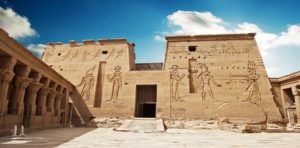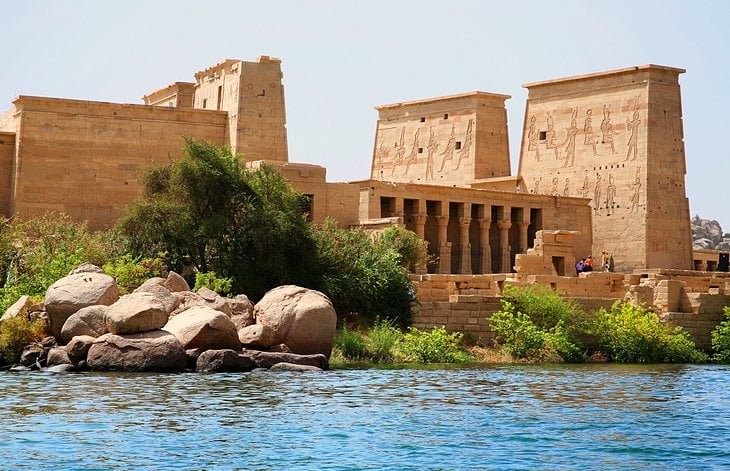Philae Temple or the temple of Isis at Philae Island in Aswan is one of the most beautiful temples in Egypt. It is known as the “Pearl of Egypt”. The temple is located on an island, so it requires a short boat ride. The boat is taken from the Shallal boatyard south of Aswan, where you can also buy tickets to the temple.
The official price of the boats is posted at the dockyard, but this only allows for a one-hour visit, so if you want to spend more time, you should negotiate with your captain.
Philae Island:
The name Philae is derived from the ancient name of the island ‘pilak’ or ‘philak’ which means “remote place” or the “end”. According to the myth of Isis and Osiris, the heart of Osiris was buried on Philae. While his left leg was buried at the nearby island of Bigah.

Bigah Island was viewed by the ancient Egyptians as the source of the Nile. Bigah was the first tip of land to appear out of the primeval waters. It was so sacred that only the priesthood had access to it.
At Philae Island, the popular cult of Isis developed. The image of Isis was ferried over to Bigah every ten days so that the goddess could be reunited symbolically with her husband Osiris.
Myth of Isis and Osiris:
Osiris, Isis, Nephthys, and Seth were children of Geb (Earth) and Nut (Sky). Osiris married Isis, and Seth married Nephthys. Later, Osiris became the god-king of Egypt. Seth (Evil) became very jealous and decided to get rid of his brother.
Seth made a golden coffin that fits only the body of Osiris. He invited Osiris and some of his followers to a great banquet. Then he told his guests that he has a wonderful golden coffin as a gift for anyone that fits it. All, one by one tried to go into the coffin but in vain. It is the time of Osiris to try. He went into the coffin, and it was perfectly fitting him. Seth and his followers closed the coffin while Osiris was inside, and they threw it into the River Nile.
Isis, the faithful wife, searched for the coffin until she found it in Babylos (modern Lebanon), was taken there by the Mediterranean. With her magic powers, Isis brought her husband back to life and brought him back to Egypt.
In fear of Seth, Isis decided to hide her husband in the papyrus marshes in the Delta. In one of his hunting trips at the marshes, Seth found his brother alive. He could believe that then he chopped Osiris into 14 or 16 pieces. He scattered them far and wide in Egypt. All pieces were scattered on the ground but Osiris’s phallus was thrown into the river.
Isis searched for the pieces of her husband’s body. She collected 13 or 15 pieces but the phallus was eaten by a catfish. Isis attached mud phallus to Osiris’s body and brought him back to life again.
Later, Horus was born and started his revenge against his uncle Seth. Then to settle that war between Seth and Horus, Egypt was divided between them. Seth was given the desert while Horus was given the fertile land.
Explore the island:
Pharaoh Nectanebo I (380-362 BC) was responsible for the earliest surviving substantial structure and for the overall layout of the island. Nectanebo’s Kiosk is at the south end of the island where modern boats dock.
Philae developed on the grand scale during the Greco-Roman Period. The large temple of Isis was built in this Ptolemaic period. Isis, the goddess of love and magic in ancient Egypt was identified as Aphrodite by the Greeks in Egypt.
Beyond Nectanebo I’s kiosk lies a vast court, surrounded by elegant colonnades, in front of the massive first pylon of the temple of Isis.
Temple of Isis:
The temple of Isis is entered through the first pylon built somewhere between 200 and 160 BC. In familiar fashion, it is decorated with an image of Ptolemy XII, smiting Egypt’s enemies before Isis, Horus of Edfu, and Hathor. The main gate of the pylon is flanked by two granite lionesses. Inside the gate is an inscription left by Napoleon’s soldiers in 1798.

Taking the small door to the left, you can see the lovely carvings of Isis suckling her baby, Horus in the marshes of the Delta in the 3rd century BC Birth House (Mamisi), built by Ptolemy III. This is sometimes cited as the origin of the Christian image of the Virgin Mary suckling the infant Christ.
Inside Isis Temple:
The main gate of the first pylon leads to an open court with the mamisi to the left-hand side and some storerooms to the right-hand side. The second pylon is smaller than the first and was built by Ptolemy VI.

The limited area available for building on the island seems to have caused a number of modifications to the standard plan of Ptolemaic temples. Generally, as builders run out of space, the axis of new buildings accommodated the shape of the island.

The second pylon leads to the Hypostyle Hall. This hall has some elegant columns and it was converted into a church during the Coptic era. Coptic crosses can be seen on the columns and on the walls of the hall. A granite altar and a tiny niche are found on the right side of the hall.
Beyond the Hypostyle Hall are some other halls and the sanctuaries of the temple. In the middle sanctuary, Isis can be seen resurrecting her husband and suckling her baby, Horus. A granite cubic block is in the middle of the sanctuary for the sacred bark. Stairs lead up to the upper floor and the Osiris Room with reliefs depicting the story of Osiris and Isis.
Hadrian’s Room:
A relief alluding to the source of the Nile can be seen in Hadrian’s gateway, just to the west of Isis Temple. It shows blocks of stone heaped one upon the other, with a vulture (representing Upper Egypt) and a hawk (representing Lower Egypt) standing on top. Beneath the rocks is a circular which is outlined by the contours of a serpent within which Happi, the Nile-god, couches. He clasps a vessel in each hand. Also here is a beautifully tender scene of Isis looking at a crocodile carrying her husband’s body to Bigah.
A temple to Hathor was built to the east of Isis Temple. Bes, the god of childbirth and amusement in ancient Egypt, is depicted in Hathor’s temple plays with different musical instruments.
Kiosk of Trajan:
One remarkable building of Philae Island is certainly Trajan’s Kiosk or the “Pharaoh’s Bed” as the Egyptian call it. The kiosk dating from 100 AD, has 14 columns and unfinished inscriptions. Only two of the inscriptions show Emperor Trajan presenting offerings to Isis and Horus, her son.

The monuments at Philae, particularly Trajan’s Kiosk, are covered in graffiti from almost every era of history. A Greek inscription in the Osiris shrine above the sanctuary of Isis Temple reveals that even as late as 453 AD, Isis was worshipped here by the Blemmys, tribes of the Eastern Desert, long after the edict of Theodosius had declared that pagan temples should be closed. The monuments at Philae, therefore, represent the last outpost of ancient Egyptian tradition on its native soil.
Saving the temple:
After the first dam was built, the temple was under the water for six months of the year, and the rest of the time visitors could sail amongst its ruins by boat. Amelia Edwards visited the temple in this way, and wrote her famous novel “A Thousand Miles Up The Nile” and titled Philae as ‘Pearl of Egypt’.
The creation of Lake Nasser following the building of the High Dam threatened to submerge the temple completely, so it was moved to the nearby island of Agilikah, which was landscaped to resemble the original site.
The salvage contract to rescue the temple from the water was awarded to an Italian company that started with the construction of a cofferdam in 1977. The temple was dismantled into 47,000 blocks. The stone blocks were then cleaned and stored. Meanwhile, 450 tonnes of granite were blown off to the top of the neighboring island of Agilikah to accommodate the temples. Some of the granite was used to enlarge part of the island so as to resemble the shape of Philae.
The stones were then transported to their new home and, in just 30 months, re-erected. Many of the blocks were replaced in course of the reconstruction so the result is rather pristine, but you can still see a water-level mark on the entrance pylons. The old island of Philae is surrounded by a sandbank and the rusty remains of the cofferdam are still visible from Agilikah.
The temple of Isis at Philae is a must-see place when you’re in Aswan. So we include it in most of our Egypt travel packages and in some of Aswan Day Tours.

